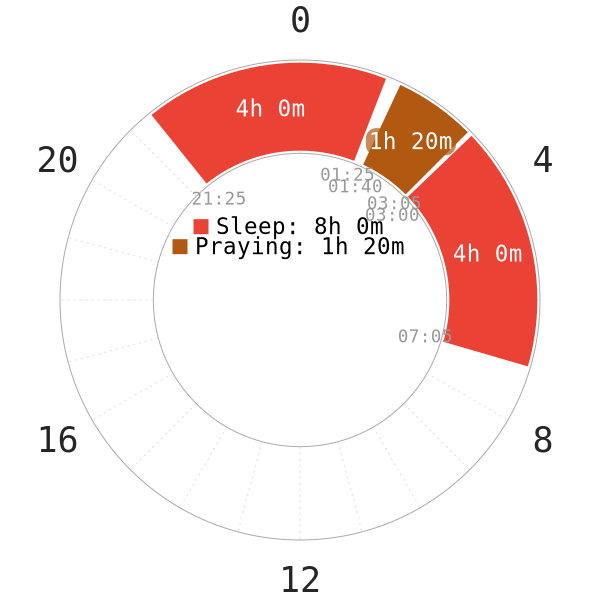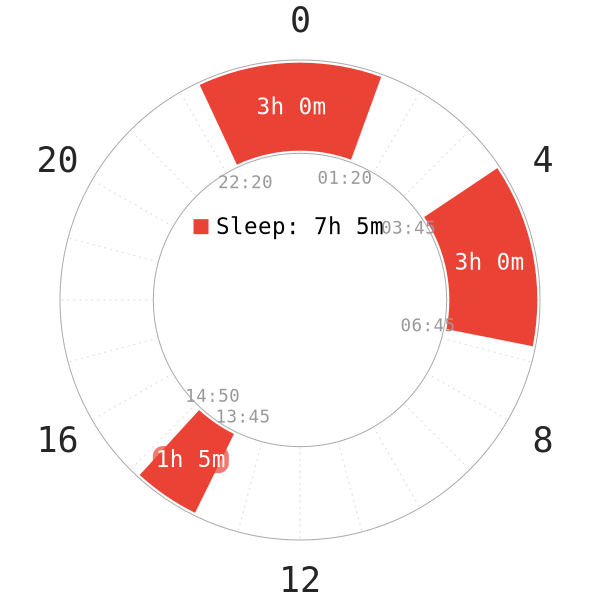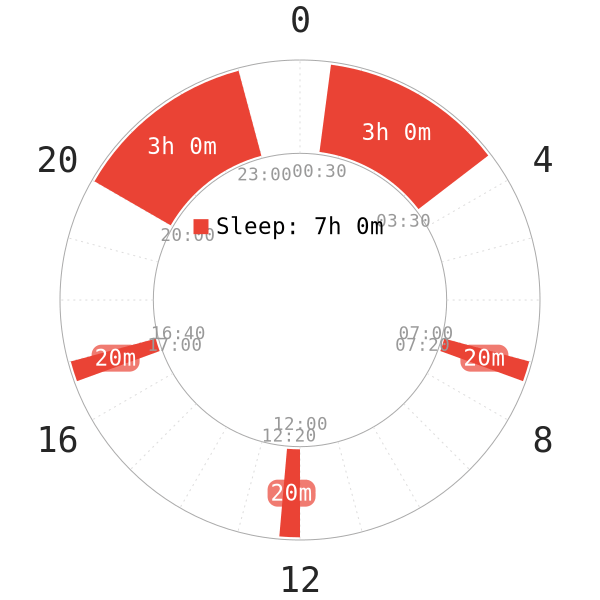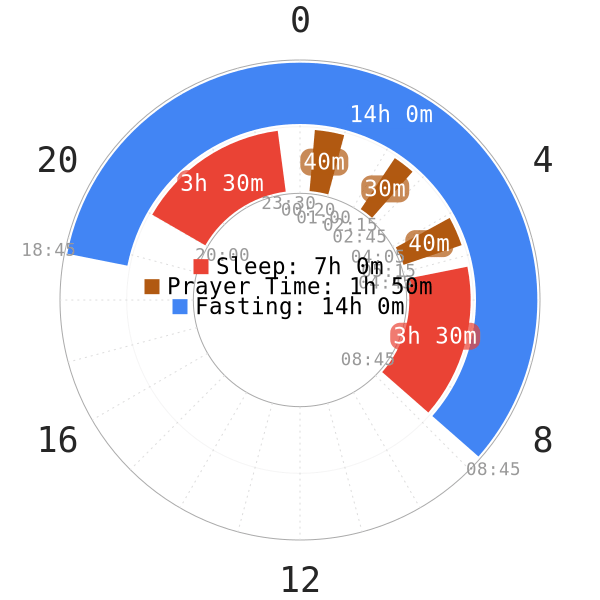Introduction
Religion has deep roots in human culture and history. The ideas present in multiple religious books, including the Bible, interestingly give some hints about human sleep. Although there are discrepancies across different versions, one would need to pay attention to the details. And surprisingly, polyphasic sleep again makes its appearance in multiple sources.
However, it is not until recently that there is some recognition for alternate sleep patterns for prayers. And to a lot of people’s surprises, these sleep schedules actually work very well for these dedicated prayers. This obviously includes certain adapted prayers in our community. Thus, this post will detail certain scheduling possibilities that can fit this highly specific lifestyle.
History
As mentioned earlier, polyphasic sleeping did have its niche in the religious world. Obviously, that niche does carry over today’s religion.

- In the Bible, there are very direct hints that prayers did follow the segmented sleep pattern1. What is typical is that prayers spend some time awake at night on praying, before heading back to bed until sunrise. They also go to bed early in the evening, usually after sunset.
- Long ago, in the reformed Protestant society, individuals also practiced segmented sleep2. However, this was only old monastic disciplines regarding sleep. However, one thing that stands out is that they did pay attention to vivid dreaming.
Given that the list is not fully inclusive, there may be potentially more examples on split-sleep behavior in humans. Nonetheless, from the given literature, we know that these prayers not only care about dreaming, but also the spirituality of the practice. Specifically, these individuals consider praying a divine privilege; rising at night and spending the silent hours on deep contemplation and retrospection reflect a quite unique lifestyle.
Current Era
Overall, there is an unanimous consensus on the popularity of Segmented sleep prior to the industrial revolution3. Nowadays, there is still involuntary practice of similar polyphasic patterns.
- Arab Muslims have specific sleep patterns. Specifically, they have five prayers a day; one of which is one hour before sunrise. As a result, they naturally practice Segmented sleep4.
- Likewise, some other Muslims practice some kind of Siesta sleep schedule, with a daytime sleep session5. The Quran specifically mentions napping. Most notably, they favor sleeping on the right side in the initial part of sleep. This is because there are certain benefits for the heart in this sleep position.
- Omani adults, especially those who are part of the Muslim community, also practice Segmented sleep, Everyman 1 and Siesta4. However, their total sleep suggests that their sleep patterns are all non-reducing.

- There was, however, no specification on specific polyphasic sleep patterns that Omani adults follow.
- Speculatively, certain Omani adults may practice some sort of Dual Core/Triphasic-extended schedules. The study concluded that the vast majority of them took daytime naps of at least 1 hour long. This also combines with the common segmentation of sleep into two portions at night.
- Most notably, individuals with more than two sleep segments daily have the highest sleep quality, even more than the biphasic/siesta group.
- Those who practice Ramadan also follow a biphasic schedule. However, non-Muslims have shorter daytime naps (Everyman 1-alike) while Muslims have longer daytime sleep (Siesta-alike)6.

- Anecdotally, the polyphasic community in the Discord also reports one dedicated prayer with Dual Core 3-extended. He spends the small 90m wake period between 2 cores praying. The schedule has a high total sleep because of his physically active lifestyle.
Extra Notes with Polyphasic Sleeping & Praying Lifestyle
General Notes
When designing a polyphasic sleeping schedule, you should take possible prayer times and fasts into consideration.

- Since the prayer times could move on a daily basis, you should aim to have a clear one or preferably two-month timespan. This is to make sure no prayer times will interfere with sleep times during adaptation.
- If your prayer schedule is consistent, outline the times and schedule your fasting hours and sleep times around it.
- When the time comes, it may be necessary to reschedule around these times. You can pick either methods:
- Doing a Daylight Saving Time shift
- Flexing sleep by simply shifting nap times if you have been adapted for a while.
- During your prayer period, if you cannot stick to any consistent sleep times, consider a non-reducing biphasic schedule, but with dark period and only slightly flexible sleep times.
Cautions for Ramadan
Ramadan is without a doubt one of the most extreme ways to do fasting per each religion. Thus, there are a couple things you would want to pay attention to when you do this long fast.
What Happens during Ramadan
- The Ramadan month is a lunar month, which means the timing of Ramadan changes every year6.
- Personal bedtime and wake time are also delayed during Ramadan month7.
- Suddenly shifting your regular nocturnal pattern to the common Segmented sleep pattern during Ramadan can be a challenging process. It can affect your daytime sleepiness levels and daily performance. Thus, in anticipation of this event, you can adapt to some kind of Segmented sleep.
- Non-polyphasic sleepers or non-habitual nappers can suffer during this long fast. Their circadian changes go along with their new sleeping, working and eating habits. As a result, even though their total sleep remains largely unchanged, they still experience a lot more tiredness8.
Methods for Polyphasic Sleepers
- Switching to a less extreme schedule could be wise during fasts like Ramadan; however, this depends on what country you live in and when it occurs.
- More total sleep will preserve your normal performance baseline. Biphasic sleep is, therefore, a good candidate to plow through this period7.
- Daytime naps can alleviate tiredness during Ramadan, even if night sleep duration has to reduce.
- Note that eating will likely set a new circadian morning if done during the night. It will cause SWS and REM peaks to move.
- Adapting during Ramadan could pose problems as well. Your temperature acrophase and maximum energy expenditure may also be delayed8. Furthermore, Ramadan fasting can affect the menstrual cycle in a negative way9.
- Eating is one way to combat sleep deprivation; in addition, energy expenditure would increase food consumption requirement during the prolonged wake time. The lowered amounts of energy will also likely increase the risk of oversleeping or giving up.
Main author: Crimson & GeneralNguyen
Page last updated: 05 February 2021
Reference
- Holladay, William L. “Indications of segmented sleep in the bible.” The Catholic Biblical Quarterly 69.2 (2007): 215-221.
- Ryrie, Alec. “Sleeping, waking and dreaming in Protestant piety.” Ashgate, 2012. 73-92.
- Penner, J. (2014). Nocturnal Prayer in the Dead Sea Scrolls. Studia Liturgica, 44(1-2), 234–246. doi:10.1177/00393207140441-223
- Al-Abri, M. A., Al lawati Ibtisam, Zadjali, F., & Ganguly, S. (2020). Sleep Patterns and Quality in Omani Adults. Nature and Science of Sleep, Volume 12, 231–237. doi:10.2147/nss.s233912. [PubMed]
- BaHammam, Ahmed S. “Sleep from an Islamic perspective.” Annals of thoracic medicine 6.4 (2011): 187. [PubMed]
- BaHammam, Ahmed. “Sleep pattern, daytime sleepiness, and eating habits dsuring the month of Ramadan.” Sleep and Hypnosis 5 (2003): 165-174.
- BaHammam, Ahmed S., et al. “The effects of Ramadan fasting on sleep patterns and daytime sleepiness: An objective assessment.” Journal of research in medical sciences: the official journal of Isfahan University of Medical Sciences 18.2 (2013): 127. [PubMed]
- BaHammam, Ahmed, et al. “Circadian pattern of sleep, energy expenditure, and body temperature of young healthy men during the intermittent fasting of Ramadan.” Appetite 54.2 (2010): 426-429. [PubMed]
- Yavangi, Mahnaz, et al. “Does Ramadan fasting has any effects on menstrual cycles?.” Iranian journal of reproductive medicine 11.2 (2013): 145. [PubMed]
